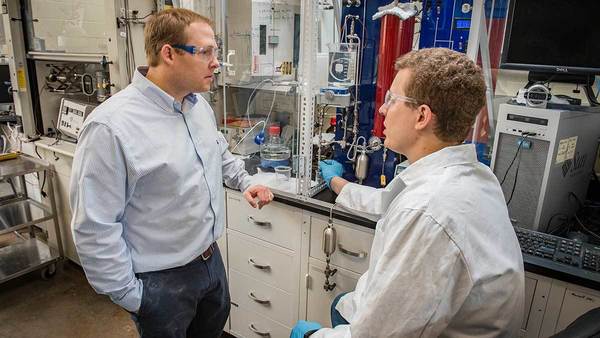

Chemical engineers at the University of Notre Dame will contribute their expertise in materials development and modeling to a new research center that will focus on new methods of converting shale gas reserves into chemicals and transportation fuel.
The Center for Innovative and Strategic Transformation of Alkane Resources (CISTAR) has been awarded a five-year, $19.7 million grant from the National Science Foundation and aims to spur economic growth and job creation in shale resource regions.
Estimates of shale gas reserves in the United States project sufficient supplies to power the country for the next 100 years.
“This research will change the ways in which we convert shale gas into liquids and should positively impact the U.S. economy and reduce greenhouse gas emissions,” said Peter Kilpatrick, McCloskey Dean of the College of Engineering at Notre Dame. “CISTAR’s unique model is a valuable resource, offering insight to companies at the forefront of a growing industry.”
The center is a collaborative effort among leading academic scientists, engineers and industrial affiliates. Their goal is to develop and demonstrate technologies for maximizing the value of processing shale gas for transportation fuel and petrochemicals.
“Shale gas presents a unique challenge in that the chemical makeup of gas deposits varies from one shale field to another,” said William F. Schneider, H. Clifford and Evelyn A. Brosey Professor of Engineering in the Department of Chemical and Biomolecular Engineering at Notre Dame. “Today’s petrochemical infrastructure was not designed with shale gas in mind. We have an opportunity to reinvent that infrastructure to generate increased economic value from these resources. The technical concept is to develop modular systems that have the flexibility to adapt to diverse shale reserves and the mobility to be located as needed close to the reserves. This minimizes transportation challenges and brings jobs to the communities in which the reserves are located.”
CISTAR is structured to generate ideas in the lab and move them closer toward implementation by working with member companies.
“Member companies will have early access to research, input on directions of that research, and will have the option to fund specific work relative to their needs, which is a big innovation opportunity,” Schneider said. Those companies will pay annual dues to support the center’s activities.
Along with basic research and development of new processes, CISTAR includes a full-scale approach to education and outreach — from valuable graduate and undergraduate training to community engagement.
Outreach directors at Notre Dame and Purdue will work with K-12 students, exposing them to big picture ideas in energy and chemistry as well as environmental impact.
CISTAR will be led by Purdue University, which shares a long history of collaboration in the area of catalysis with Notre Dame. Partner institutions include Northwestern University, the University of New Mexico and the University of Texas at Austin.
Originally published by at news.nd.edu on September 12, 2017.